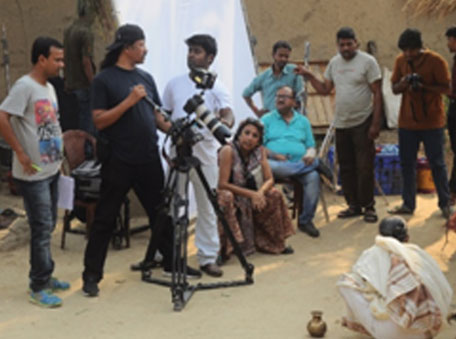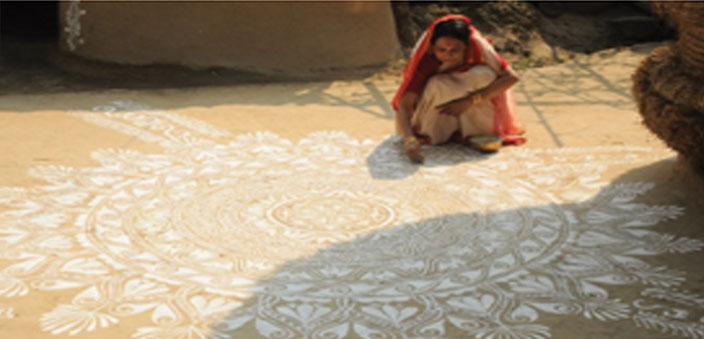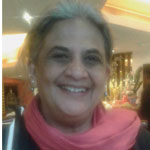When man started the art of painting images, it became a source of communication between him and others. It first began with the concept of appeasing the unknown power that people in ancient times believed in; a force that controlled their lives. Women folk, both from animistic tribes and rural communities, have been performing specific rites to their gods in order to obtain divine blessings that would safeguard them and their loved ones from misfortune, and provide health and prosperity to their families.
Down the ages, this appeasement or prayer took the form of broto or vows in rural Bengal, where the predominant occupation was farming. Vows would be undertaken to satisfy the gods with a view to achieving fulfillment of one’s wishes. Furthermore, women belonging to this agrarian lifestyle observed their vows following the ritual of drawing specific decorative motifs with their fingers, known as alpana (pronounced alpona), derived from the Sanskrit word alimpana, which means ‘to plaster’ or ‘to coat with’.
Alpana can be compared to rangoli, which is an essential part of our culture that has given rise to beautiful designs that can be replicated elsewhere. It is a beautiful tradition of ephemeral beauty – an art that is created only to get pale with time, or scattered away if dry powder is used. In the manner that beautiful clay images of gods and goddesses are immersed in water as a symbol of dust to dust, embodying the very essence of life.
A unique art form
The tradition of broto alpana in Bengal is unique in several ways. It was believed that the force generated from the ‘magic’ of such ritual would yield the desired results. So basically, broto alpana marries the two elements of invocation – prayer and painting – in a message to the gods to grant wishes. Broto or vrat is similar in that it entails fasting as part of the vows taken. They have long been associated with agriculture – for fertility of the soil, to induce rain and to protect crops. The other reasons were human fertility and wealth. They were also observed to cure diseases, evade disasters, grant good husbands and a variety of miscellaneous needs. Sometimes, the objective of these broto was also negative, a desire to harm others – especially the co-wives. The women came together and needed no priest to do this. Dipping their fingers into the soaked and ground rice paste they drew beautiful patterns on the floors of their houses, on walls, courtyards etc. Along with this exercise, they composed and recited rhymes or chhara, praying for the above. Sometimes, they chanted these as they painted or encircled the drawings together in rhythmic motions. “The specificity of these rituals was targeted,” says Phoenix based Sarbari Chowdhury who has recently made a documentary Finger Painting Messages to the Gods. It focuses on this vanishing ritual, still prevalent in some parts of rural Bengal. “If they needed rain, the rituals included verses and alpana referred to the prayer for rain. Similarly, if the ritual was for a good harvest, the alpana and charra verses depicted a sheaf of golden rice plants, overflowing granaries. In that they are not generic,” she adds, her half-hour film throwing light on the ritualistic processes leading to the actual painting.
Hindu Bengali women are known to keep broto on a number of occasions. The widows were known to be imposed with a number of broto rituals, perhaps, to keep them busy. There were three kinds mainly. The shastra broto; primarily Pouranic rituals, performed by Bramhin priests and followed formal rituals as prescribed in the Puran texts, one clear example being Durga Puja (considered the community’s biggest celebration). The nari broto performed by women, and are a mix of pre- Pouranic broto and the formal Pouranic broto, an example is Lakshmi Puja.
The young girl’s or kumari broto is the least fussy of them all and dates back to pre-Vedic times. The rituals here are performed by the women themselves, no Brahman priest is required. The steps for these broto include the preparation like first gathering all the items required; preparing the ritual area; taking a ritual bath, drawing or alpana; chanting the magic chhara verses and sometimes, orally composing them as well. Lastly, reciting and listening to a narration (brotokatha) or example of occasions when the performance of that particular broto had yielded positive results bringing good cheer to those gathered.
These rituals, over time, have thrown up talented singers, dancers, composers and artists. Those with a natural flair for any of these contributed to the group effort, perhaps giving the participatory women a sense of self-esteem otherwise confined to the drudgery of housework.
Regressive or creative expression?
So even if we can say, yes, the rituals were regressive because everything pointed to men, home, and hearth, it also gave the women an opportunity to get together and have fun, when also showcasing their artistic talent. What beautiful patterns emerged! Materials used are historically a slurry of atop chal (refined rice) for the design itself. The base is prepared with clay/mud mixed with cow dung or sometimes, to add color, red clay is added. Today an alpana is painted with zinc oxide, poster colors and the easiest of all these, in the form of pre-done stickers! “I have concentrated in areas like Nadia, Burdwan, Birbhum and closer to Kolkata – the 24 Parganas,” says Sarbari. “What I found is that the style of drawing differs between the Santhal tribal community and the Bengali community, Hindus and Muslim. The film follows some of the women as they innovate and take creative licenses as they give vent to their innate sense of lines and forms.
Taking a cue from that, Urmi Rahman, former journalist with BBC Radio explains, “The art of alpana though not connected with any broto among the Muslims, is an important art form in Bangladesh. On Language Day, February 21, students from the state art college draw one of the longest alpana on the streets that have captured world attention.

Stylised local vines, figurines and flowers feature predominately in broto alpana. The other type of alpana which is drawn during weddings, bhai dooj and other festivities, can refer to beautiful designs, simple and elaborate, made popular over the years.
Whether broto alpana is a regressive ritual comparable to say karwa chauth is debatable, but in the words of Madhupa Bakshi, who has grown up with a tradition of alpana during various religious rituals: “In today’s global world where oneness of culture and lifestyle are being emphasised, there is a definite need to preserve our unique cultural traditions in whatever form.” As Dean, Media Science Department, Heritage Academy, Kolkata, she understands the importance of traditional forms of communication that exists among various communities.
“We welcome guests with alpana and rangoli which are manifestations of our unique culture and artistic expressions irrespective of the gender angle.” That alpana has also seeped into larger folk-art styles in Bengal are there for all to see.
But for women of the past steeped in agrarian culture, broto alpana helped them to communicate their heart’s desires to the gods while expressing their artistic abilities in their own way. This was but one way for them to feel appreciated, and admired by the bigger community around them.


 [/column]
[/column]